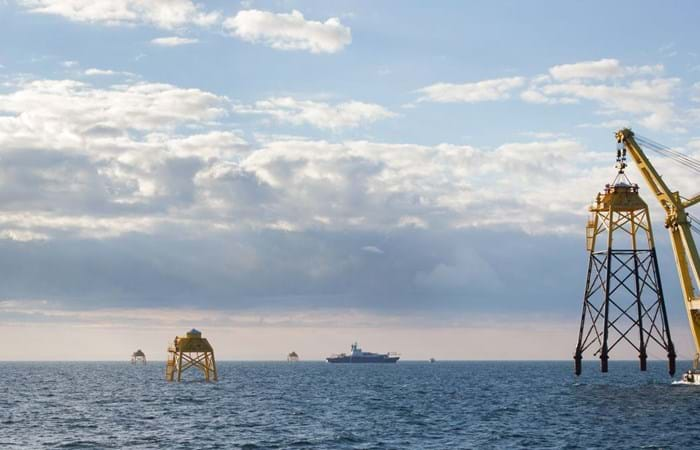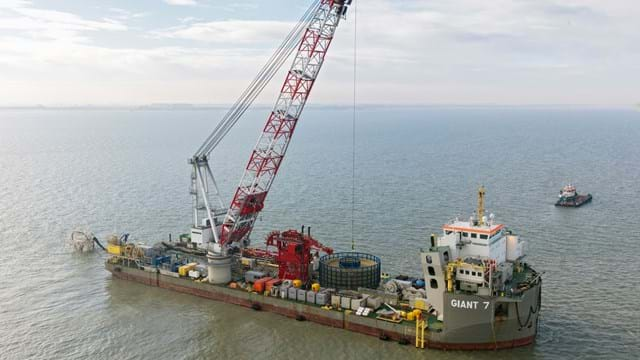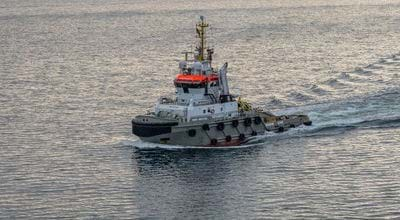<div>The Wikinger offshore wind farm has been developed by Iberdrola in the Baltic Sea area, within the German Exclusive Economic Zone (EEZ). The offshore site is about 34 km northeast of the island of Rügen, and covers an area of roughly 50 km², within which 70 wind turbine generators (WTG) of 5 MW and one offshore substation (OSS) are being installed. The water depths for installation range between 36 and 42 meters. When completed the windfarm will deliver 350 MW electrical power to the German national grid. The transport and installation of the 70 WTG foundations and the piles for the OSS has been carried out by Boskalis.</div>
Foundations
Each of the WTG foundations consists of a four legged jacket including a transition piece and four piles. Lengths and weights vary due to different water depths and soil conditions. The piles are driven into the soil prior to jacket installation (pre-piled foundation concept). Furthermore the piles are dredged and cleaned internally prior to jacket installation. After installation of the jacket the connection between the jacket and the piles has been realized by grouting.
Transport
A significant part of the Boskalis scope comprises the safe transportation of the piles and jackets from their fabrication sites in Seville, Aviles and Fene-Ferrol, Spain, and from Lindø and Aalborg, Denmark to the Iberdrola feeder port in Sassnitz, Germany. A variety of assets has been deployed for the transportation. Piles are transported using tugs and barges for the transports from Aalborg and geared vessels from Seville and Aviles. Jackets from Lindø are also transported by tugs and barges. The transport from Fene-Ferrol via the Bay of Biscay and the North Sea to the Baltic Sea has been done by Dockwise S-class vessels (Swan and Tern) on 7 consecutive voyages transporting 4 jackets each voyage.
Installation
Installation of the jacket foundations comprises four consecutive steps. The piles are driven into the seabed using a specially designed self levelling pre-piling template able to position the piles to the exact tolerances. The piles are driven by a 1200 kJ hydro-hammer. The template and hammer spread are deployed from the Giant 7 converted for the Wikinger Project into an offshore crane barge by installing a 1000 t Liebherr crane. Once installed the piles are dredged and cleaned using specialist tools deployed from two DP vessels. Jackets are installed with one of the Boskalis sheerlegs Taklift 4 with a capacity of 1400 t. After installation the annulus between the jacket legs and the piles has been grouted using high strength grout pumped from a grout factory deployed from another DP vessel. After grouting the jacket foundation has been inspected and handed over to the client.
Tailor made vessel and specialist tools
A wide range of self-owned vessels have been deployed on the Wikinger project ranging from support vessels, multicats, tugs, barges, a rock dumping vessel, installation vessels and one of our sheerlegs. In addition various support vessels, tugs and barges were hired on the project. In total some 25 vessels were deployed.
Noise mitigation
Noise mitigation measures are in place during pile driving to meet the strict requirements set by the German Authorities for pile driving in the Baltic Sea. Three noise mitigation measures have been applied:
- Double big bubble curtain on the sea bottom around the template and the installation vessel (Giant 7)
- Small bubble curtain around each of the four cages of the pre-piling template
- Hydro sound damper deployed around the pile (contingency in case the criteria are not met)
All installation activities have been executed well within the noise limits ISO requirements.
Conclusion
Boskalis has proven its capability to execute complex projects to the highest safety and environmental standards overcoming difficult technological challenges using tailor made vessels and equipment.


